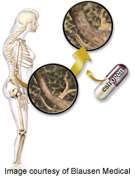Pattern of estrogen-progestin use from 1970 to 2010 described

(HealthDay)—The use of estrogen-progestin has varied over the past 40 years, peaking in the 1990s and declining in the early 2000s, according to a study published online Sept. 8 in Obstetrics & Gynecology.
Patricia I. Jewett, from the University of Wisconsin-Madison, and colleagues integrated data on oral estrogen-progestin use from the National Health and Nutrition Examination Survey (1999 to 2010) with data from the National Prescription Audit (1970 to 2003). Long-term trends in estrogen-progestin prevalence were estimated for 1970 to 2010.
The researchers found that the estimated prevalence of oral estrogen-progestin was below 0.5 percent in the 1970s and began to rise in the early 1980s. Between 1990 and the late 1990s the estimated prevalence almost tripled. For women aged 45 to 64 years, the age-adjusted prevalence peaked at 13.5 percent in 1999, with highest use among women aged 57 years (23.3 percent). In the early 2000s, the prevalence of estrogen-progestin use declined dramatically, with use estimated at 2.7 percent for women aged 45 to 64 years in 2010, comparable to prevalence in the mid-1980s.
"The dramatic rise and fall of estrogen-progestin use over the past 40 years provides an illuminating case study of prescription practices before, during, and after the development of evidence regarding benefits and harms," the authors write.
More information:
Abstract
Full Text (subscription or payment may be required)
Copyright © 2014 HealthDay. All rights reserved.
















